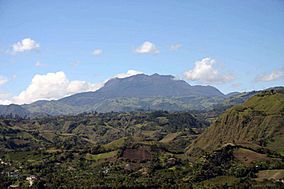Doña Juana-Cascabel Volcanic Complex facts for kids
Quick facts for kids Parque Nacional Natural Complejo Volcánico Doña Juana-Cascabel |
|
|---|---|
| Doña Juana-Cascabel Volcanic Complex National Natural Park | |
|
IUCN Category II (National Park)
|
|

Panoramic view of the Doña Juana volcanic field
|
|
| Location | Nariño and Cauca, |
| Area | 65.858 acres (266,520 m2) |
| Established | March 23, 2007 |
| Governing body | SINAP |
The Doña Juana-Cascabel Volcanic Complex National Natural Park (in Spanish, Parque Nacional Natural Complejo Volcánico Doña Juana-Cascabel) is a special protected area in Colombia. It's like a huge natural reserve. This park is located in the southern parts of Colombia. It stretches across two departments: Nariño and Cauca. The park gets its name from three important volcanoes found within its borders. These are the Doña Juana, Petacas, and Las Ánimas volcanoes.
Contents
About the Doña Juana-Cascabel Park
This park is a National Natural Park in Colombia. It was created to protect its amazing nature. It helps keep the plants, animals, and volcanoes safe. The park covers a large area of land. It was officially established on March 23, 2007. This means it has been protecting its unique environment for many years.
Where is it located?
The Doña Juana-Cascabel Park is in the southern part of Colombia. It is found in two different departments. These are the Nariño Department and the Cauca Department. The park covers parts of several towns. In Nariño, it includes areas from El Tablón, San Bernardo, La Cruz, and San Pablo. In Cauca, it includes parts of Bolívar and Santa Rosa.
What's in a name?
The park's name comes from three important volcanoes. These are the Doña Juana, Petacas, and Las Ánimas volcanoes. These volcanoes are a big part of the park's landscape. They help make the area very unique and beautiful. The park protects these natural wonders.
Why is it special?
The Doña Juana-Cascabel Volcanic Complex National Natural Park is important for many reasons. It protects different kinds of plants and animals. Many of these species can only be found in this region. The park also helps keep the natural environment healthy. This includes the air, water, and soil. It is a place where scientists can study nature. It also offers a chance for people to learn about Colombia's amazing natural heritage.
See also
 In Spanish: Parque nacional natural Complejo Volcánico Doña Juana - Cascabel para niños
In Spanish: Parque nacional natural Complejo Volcánico Doña Juana - Cascabel para niños

